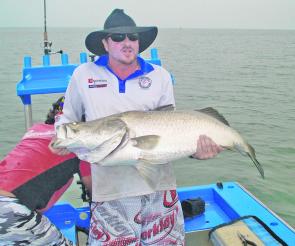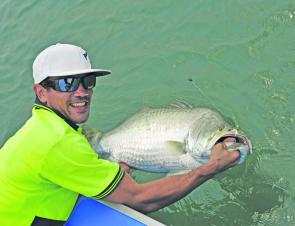Not too much to report about the past month with the barra season shut plus the monsoon in full swing. However, the inshore fishing has seen mixed results.
Some friends of mine have done pretty well jigging soft plastics around the northern end of Hinchinbrook Island. Fingermark to 5kg and a bunch of good sized GT and queenfish have kept them entertained on a couple of occasions while fishing the deeper headlands at Cape Richards and the back of Gould Island.
There have also been rumours of grunter showing up in the shallow flats of the northern end but I’m not sure where they have been fishing the best. Sometimes the grunter will be caught in one area and not others so it depends upon where the schools are moving at the time. Best options would be to move around and give it half an hour at different locations.
The grunter certainly have not been up to their usual standards this year but I suspect that their foraging areas have been upset by cyclone Yasi we had this time last year. One thing I have noticed this past year is that many of the sink holes and inshore patches of reefy and rubble bottom are filled over so that gives you an idea of how much the surge upset things. Hopefully the tides will naturally wash away the all the rubbish and silt in the coming year or two and re-establish many of their traditional grounds.
I don’t have any reef reports but I would imagine that it’s been a little quiet as it is traditionally the slower time of year out there, unless you fish the deeper waters at night.
This is also be the slowest time of year for most of our pelagics, apart from GT inshore and tuna in the shipping lanes. Grey mackerel should also show up among the tuna schools as well.
February heralds the start of the barra season and waterways on the east coast will once again abound with anglers targeting the famous sportfish. Lure casters will no doubt punish the drains and backwaters of the Hinchinbrook Channel until they turn to froth, but they may get some average results if we see some heavy rains and that also makes for unpleasant fishing. I find that they start to fish better around the March period when there’s a heap of fresh water around during February.
Live bait anglers should also try their luck in the deepest holes when there is a lot of fresh around as the saltwater is mainly on the bottom particularly on the neap tides. They will also become hard to mark on your depth sounder as the fish are generally on the move which means their swim bladders will be deflated and will not show much return on your screen. My advice is to fish deep in this situation even if you don’t mark many fish.
Another issue with the fresh can be the availability of good live bait as much of it moves away from the channel and out on to the northern beaches so a little research could be in order. Whatever happens I’m looking forward to another bumper season with plenty of metre-plus fish keeping my clients amused.
For those of you keen to come up for this years’ barra season, start planning soon as all my best dates will slowly soak up. To contact us check out our new website at www.hookedonhinchinbrook.com.
Reads: 1574
The barra season last year ended with a bang with some excellent specimens brought on board.

February heralds the start of the barra season and waterways on the east coast will once again abound with anglers targeting the famous sportfish.




